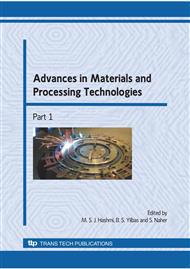p.143
p.150
p.157
p.165
p.174
p.182
p.190
p.198
p.206
Effect of Mold Surface Topography on Uneven Shell Growth in Solidification
Abstract:
The unstable shell growth pattern in the early solidification stages results mainly from the unevenness of the heat flux drawn from the mold surface. This heat flux is determined either by the size of the air-gaps formed between the solidifying shell and mold surface or from the value of the contact pressure. Present work examines the role of the mold surface topography on gap nucleation and the contact pressure variation in pure metal solidification. The results of the present study can be used to tune mold surfaces for the control of cast surface morphologies.
Info:
Periodical:
Pages:
174-181
Citation:
Online since:
December 2009
Authors:
Price:
Сopyright:
© 2010 Trans Tech Publications Ltd. All Rights Reserved
Share:
Citation:


